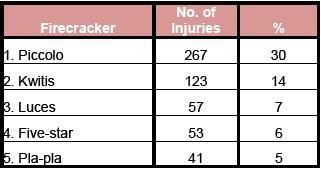The number of revelry-related injuries reported by sentinel hospitals nationwide inched closer to a thousand as of January 3, a quarter or 190 cases more than a year earlier, latest data from the the Department of Health (DOH) showed. In its 6 a.m. bulletin on Sunday but posted only on Monday, the DOH said 920 cases have been recorded so far — 877 injuries due to fireworks, 1 from watusi ingestion, and 42 due to stray bullets. The recent tally, based on reports by 50 selected hospitals nationwide, was a big leap from the 807 reported as of Saturday morning. Of the 877 reported injured, more than three-quarters or 671 did not involve amputation, a tenth or 81 involved cutting off limbs and 14 percent or 125 were related to eye injuries. While the 920 tally was 2 percent lower than the five-year average, it was a quarter or 190 cases more than the 2008 count, the Health department said in a report.

In a phone interview, Yolanda Oliveros, head of the DOH's National Center for Disease Prevention and Control, traced the rise in revelry-related injuries to several factors, including the weather. "It rained last year, so perhaps many hesitated to buy and use firecrackers," she said in Filipino, adding that lighting up firecrackers to celebrate the New Year remains a part of Filipino culture.
Oliveros noted that the illegal
piccolo, a small firecracker lit like a matchstick, was the leading cause of firecracker-related injuries. She said
piccolo remained easily accessible even to children because it is cheap. The DOH had been campaigning against fireworks since November, but the rise in injuries this year only showed that the department needs the help of local governments in preventing access to illegal firecrackers, she said. "We still need to have stronger advocacy among local government units. If they pass an ordinance banning residential use of fireworks or if they confiscate illegal fireworks, there would be fewer injuries and less damage," Oliveros said. "They have the power to implement [the law] and regulate [the industry]," she added.
— LBG/NPA, GMANews.TV 






